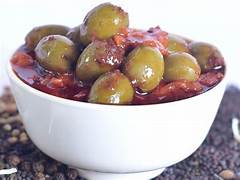Olives and pickles are two savory delights that have earned their place in cuisines around the world. These flavorful and often tangy treats offer a satisfying contrast to many dishes, from salads to sandwiches and beyond.

Let’s explore the world of olives and pickles, their history, varieties, and culinary uses:
Olives:
Olives are small, oval-shaped fruits that are harvested from olive trees. They are a staple in Mediterranean cuisine and are appreciated for their unique, briny taste and versatility.
Varieties of Olives:
Green Olives:
Harvested before they fully ripen, these olives have a firmer texture and a slightly bitter taste.
Black Olives:
Ripe olives that have a milder, fruity flavor and a softer texture.
Kalamata Olives:
Dark purple, almond-shaped olives with a rich, complex flavor.
Castelvetrano Olives:
Bright green and buttery with a slightly sweet taste.
Culinary Uses of Olives:
Antipasto Platters:
Olives often star in appetizer platters alongside cheese, cured meats, and pickles.
Salads:
Sliced or whole olives add a burst of flavor to salads, especially Greek and Mediterranean varieties.
Tapenade:
A flavorful paste made from crushed olives, capers, and olive oil, perfect for spreads and dips.
Pickles:
Pickles are cucumbers that have been preserved in a brine solution, often infused with spices like dill or garlic. The pickling process gives them a crisp texture and a tangy, sour taste.
Varieties of Pickles:
Dill Pickles:
Known for their classic dill and garlic flavor profile.
Bread and Butter Pickles:
Sweet and tangy, these pickles are a favorite for sandwiches.
Kosher Pickles:
These are garlic-infused dill pickles, popular in Jewish cuisine.
Gherkins:
Small, sweet pickles often used as garnishes or in relishes.
Culinary Uses of Pickles:
Sandwiches:
Pickles add a zesty crunch to burgers, subs, and deli sandwiches.
Relishes:
Chopped pickles mixed with onions, peppers, and spices make a zesty condiment.
Fried Pickles:
A popular Southern treat where pickle slices are battered and fried for a crispy snack.
Preservation and Cultural Significance:
Both olives and pickles have been preserved and enjoyed for centuries, offering a tangy contrast to meals. They hold cultural significance in various cuisines, from Mediterranean to Jewish to Southern American.
Conclusion:
Olives and pickles are humble yet powerful flavor enhancers that can elevate the simplest of dishes. Whether as a side, a garnish, or a standalone snack, they add a tangy, zesty twist to culinary creations
